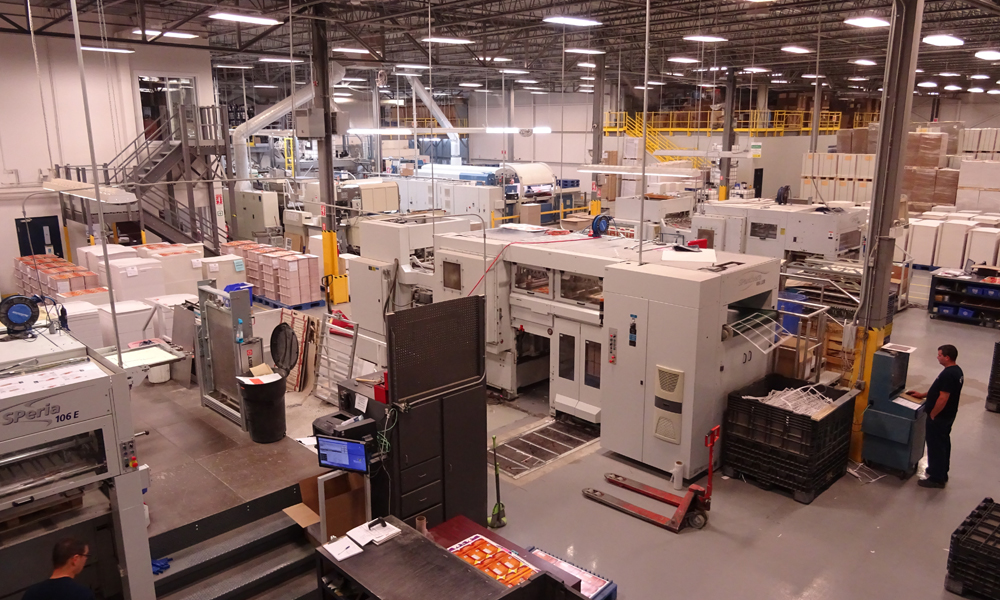Price per thousand units
When reading a price quote for a folding carton packaging, the most obvious indicator is the price per thousand units. Usually prices are quoted on various quantities to make the packaging buyer realize the potential savings of buying larger amounts. When comparing multiples quotes, one should make sure that the comparison occurs on the exact same quantities. A packaging vendor may also quote on quantities not required by the buyer to highlight the best possible option (that may be a few thousands units more than required)
Material and ink choice
On a price quote, the material should always be mentioned : material family (FBB, CRB, SBS, SUS, Micro-flute, Solidboard …), special treatments if any (Regular, freezer or ovenable for instance), the caliper usually expressed in points (1 point = 1/1000 inch) but may also be expressed in micrometer (μm). Finding the right combination of smart structural design and the thinnest possible board for the expected packaging strength is the key to the most competitive price.
The type of colors may also impact the price. The 4 color process are Cyan, Magenta, Yellow and black. From these 4 colors, most of the colors of the spectrum could be reproduced but it is recommended to use PMS (Pantone Matching System) colors for any exact reproduction of a given color to print a logo or a corporate identity related pattern. It should also be mentioned if the job is priced for water based or UV inks and varnishes. This choice may impact the type of press used, its speed and the price per thousand.
Special finishes can also added to a job like spot UV, raised UV, Soft touch varnishes for instance.
The die and the plates
The die is a one-time fee as long as the layout remains identical. For a reorder, the same die will be used and hence not charged. Any change in the layout will require a new die. Sometimes a change in the layout (especially when printing several items on the same sheet) will generate more savings than the cost of a new die.
One plate is used for each color, per layout.
The Layout and the ups
The layout corresponds to the combination of items on a sheet to be printed. On a sheet, we can have one item reproduced several times or several items combined. The number of ups is the number of items on a sheet. The more ups on a sheet, the less sheets are needed for a production, the faster the run is. When requesting a price, a customer can always ask the printer questions about the layout and suggestions to increase the number of ups and hence reduce the price.
Overs and unders
Overs are the number of items above the ordered quantity that have to be accepted by the customer. Overs are generally expressed in %. Overs of 10% could be considered as a norm, although this amount is negotiable.
Unders is the acceptable shortfall. Unders of 10% means that you agree to accept 90% of your order in case of manufacturing contingencies. You will also be billed only for what you receive.
For a manufacturer, it is considered as the margin of error in which a job should be produced.
Freight, delivery and inventory terms
It is always important to know upfront who is paying for the freight. If on the price quote, it is stated FOB “Destination”, it means that the freight is included in the unit price. If freight is included, it should mention the number of deliveries. Having a whole order delivered at once, or a skid per week will not have the same financial impact!
If an order is delivered on several releases, a quote should state besides the number of release, some inventory terms.
Having these questions clarified on the price quote will make budgeting and planning much easier.
Lead time
Although it is important for a packaging buyer to know when its order will be delivered, an expected delivery date can only be given by the manufacturer when all proofs have been approved. Then a few days are required to fit the job in the schedule, and make sure all production raw materials can be delivered on time (especially board). Delays are usually due to unavailability of board.
What Makes Us Unique: short runs, fast turnaround and flexibility
To achieve this, Netpak focuses on the best possible use of technology and automation serving a 24/7 production facility (including pre-press). Netpak has also built a trustful network of suppliers, from mills to brokers to be able to address any type of customer request with possible alternative options. We are more than a packaging printer, we are a solutions provider.
Netpak continuously invests as well on a significant inventory of boards that can accommodate most of urgent needs within hours when necessary.
A neutral approach towards board manufacturers and an extensive knowledge about board features and capabilities allow Netpak’s teams to advise our customers with the best possible carton for their needs or the best possible alternative for a better turnaround.
All internal processes have been designed specifically for fast turnaround and the highest quality standards (ISO 9001, GMI and G7 Master), security and traceability guarantees (GFSI – BRC/IOP Standard 4) and sustainability (FSC, Ecologo, SFI and PEFC). Netpak is one of the first North American packaging printer to obtain a BRC IOP certification for Packaging and Packaging Products.
But quality and fast turnaround can also be compatible with aggressive pricing. The diversity of our sourcing allows our clients to benefit from very competitive paperboard prices. The smoothness of our operations lets us run our plant with a very little amount of waste with a direct positive impact on our prices.
Do not hesitate to contact us (sales@netpak.com) in order to discuss potential collaboration opportunities, and solutions that we can bring to you.
